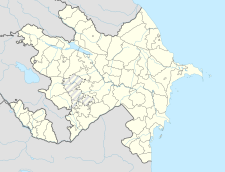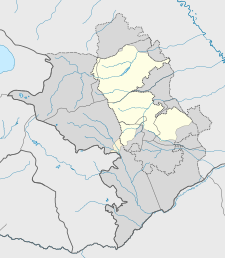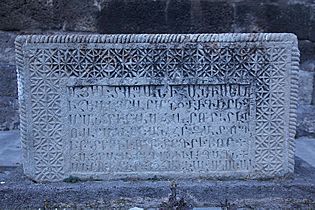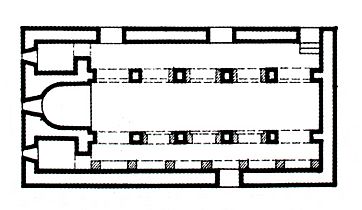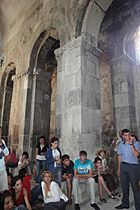Tsitsernavank Monastery facts for kids
Quick facts for kids Tsitsernavank Monastery |
|
|---|---|
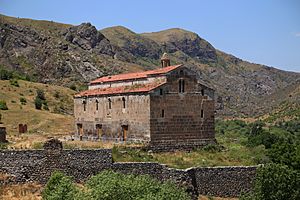
The monastery in 2015
|
|
| Religion | |
| Affiliation | Armenian Apostolic Church |
| Location | |
| Location | Hüsülü/Ağoğlan, Lachin District, Azerbaijan |
| Architecture | |
| Architectural type | Three-aisled basilica |
| Architectural style | Armenian |
| Completed | 5th-6th century |
Tsitsernavank (Armenian: Ծիծեռնավանք) is an ancient Armenian Apostolic monastery. It was built between the 5th and 6th centuries. You can find it in the Lachin District of Azerbaijan.
The monastery is about five kilometers (3 miles) from the border of Armenia's Syunik province. This area was historically known as Kashataghk (Armenian: Քաշաթաղք). In Azerbaijan, the monastery is also called Aghoghlan (Azerbaijani: Ağoğlan).
Contents
What's in a Name?
The name Tsitsernavank has two possible meanings in Armenian.
The Swallow Connection
One idea is that the name comes from the Armenian word "Tsitsernak". This word means "swallow". Researchers think this name was used because swallows built their nests in the monastery's old ruins.
The Pinky Finger Legend
Another idea is that the name comes from the Armenian word "tsitsern". This word means "pinky finger". This might be a clue that the monastery once held important items. These items were believed to be relics (special objects) of Saint George.
The Azerbaijani Name
The Azerbaijani name for the monastery is Ağoğlan (Aghoghlan). This name is thought to be linked to a river that flows nearby. The river also has the same name.
A Look at History
Tsitsernavank Monastery is located in an area once called Aghahechk. This was one of 12 regions in the historical Armenian province of Syunik. By the 1400s, Aghahechk had split into two parts. The southern part, where Tsitsernavank is, was known as Kashatagh.
Home of Holy Relics
People believed that the main church at Tsitsernavank held relics of St. George the Dragon-Slayer. The monastery was part of the Tatev diocese, which is like a church district. Historians from the 1200s and 1600s mentioned it as an important religious place.
Repairs and Changes Over Time
In 1613, the monastery's strong outer wall was fixed. A new arched entrance gate was also built. An Armenian inscription about this work was on the building. Sadly, this inscription disappeared between 1989 and 1992. This was during a conflict known as the First Nagorno-Karabakh War.
The church and its bell tower were also repaired in 1779. Another Armenian inscription about this repair disappeared in 1967.
Modern History
In the 1800s, the monastery served as a local church for the nearby village of Zeyva. It was called St. Stephanos then. The Armenian people living in Zeyva left during a conflict in 1905 and never came back.
During the time of the Soviet Union, the village was renamed Gusulu. The church was not used for worship but was kept safe as a historical site.
The church of St. George (also called St. Gevorg) at Tsitsernavank was reopened in October 2001. This happened after a big restoration project in 1999-2000. Money for the repairs came from Armenians living in other countries. Today, the monastery hosts yearly festivals to honor St. George.
The church and the Lachin District were returned to Azerbaijan on December 1, 2020. This was part of a peace agreement after the 2020 Nagorno-Karabakh conflict.
How It Was Built
The church does not have any old writings that say exactly when it was built. However, by looking at its design, experts believe it was built in three main stages.
Early Construction
The first version of the church seems to have been a simple rectangular building. It did not have an apse, which is a rounded or curved part of a church. Based on the style of its doorways, this first stage was likely built in the 5th or 6th century AD. Some people think it might even be older, from the 3rd century AD, and was originally a temple before Christianity.
Adding Key Features
In the second stage, a windowless apse was added inside the eastern end of the church. The upper parts of the outside walls were also built. This might have happened in the 6th century. During this time, the parts that separated the main area (nave) from the side areas (aisles) were probably made of wood.
Stone Pillars and Arches
In the third stage of building, strong stone pillars and arches replaced the wooden ones. These stone parts helped support the roof. Based on the style of the tops of these pillars, this work happened sometime between the late 6th century and the early 10th century.
A Special Design
Tsitsernavank Monastery is known as a unique Armenian example of an "oriental" basilica. Like many Armenian basilicas from the 5th and 6th centuries, it has three naves (long open areas). The central nave is only a little bit taller than the two side naves. Pillars separate the central nave from the side ones.
The church's design is similar to other Armenian basilicas. These include Yereruyk, Yeghvard, Dvin, Ashtarak (Tsiranavor), and Tekor. They all have a main central aisle separated from side aisles by pillars that help hold up the roof.
There is an inscription in the church that is older than the 10th century. It says, "Remember the prayers of your servant, the undeserving Grigor, for his beloved brother Azat."
Gallery
Images for kids
See also
 In Spanish: Monasterio de Tsitsernavank para niños
In Spanish: Monasterio de Tsitsernavank para niños
- Armenian culture
- Armenian architecture
- Architecture of Azerbaijan


